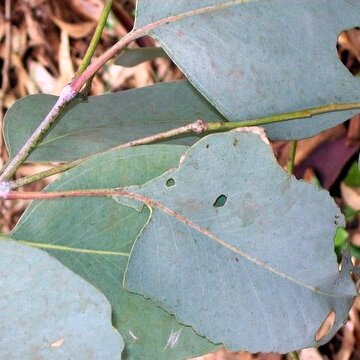Tree to 25 m. Bark smooth throughout, white or grey with grey-blue, pink or cream-yellow patches. Juvenile leaves ovate to suborbicular, grey-green, concolorous. Adult leaves lanceolate to narrowly lanceolate, acuminate, moderately thick lamina 9–16 cm long, 1–2 cm wide, green; lateral veins at 35°–50°; intramarginal vein up to 2 mm from margin; petiole terete, 15–22 mm long. Umbels 7–11-flowered; peduncle terete or angular, 7–19 mm long; pedicels 1–10 mm long. Buds conical, sometimes glaucous; operculum conical, 5–8 mm long, 3–5 mm wide; hypanthium hemispherical, 3–4 mm long, 3–5 mm wide. Fruits ovoid, subglobular or hemispherical, 4–7 mm long, 4–8 mm wide; disc broad, ascending; valves 3 or 4. Seeds brown-black.
Tree to 25 m with smooth patchy bark.. Juvenile leaves ovate or ± rounded; adult lanceolate, 9–16 cm long, 1–2 cm wide; petiole ± terete, 1.5–2.2 cm long.. Umbels 7–11-flowered; peduncle terete or angular, [0.5] 0.7–1.9 cm long; pedicels [angular] 1–10 mm long.. Operculum conical, 5–8 mm long, 3–5 mm wide.. Calyx-tube hemispherical, 3–4 mm long, 3–5 mm wide.. Fruits ovoid, ± globose or hemispherical, 4–7 mm long, 4–8 mm wide with broad ascending disc and 3–4 exserted valves; seed black.. Fig. 5/2, p. 30


